Publications

Interfaces, colloids and flows
Spontaneous structuration of biohydrogels by membrane-free osmosis
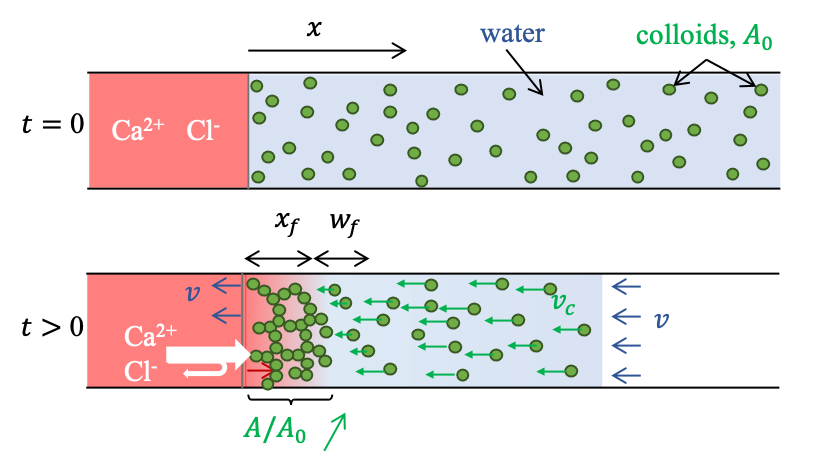
Abstract
Many bio-hydrogels are prepared thanks to the addition of divalent ions. These gels usually exhibit partial ionic selectivity, a feature is leveraged to instigate an osmotic flow during the gelation process across a range of bio-hydrogels. A simple experimental setup consisting a glass capillary filled by the reactant solution is taken as an advantage, brought into contact with a reservoir of calcium chloride. Direct observation allows to characterize the gelation kinetics, the permeability and the selectivity of several gels, including some made of protein aggregates, pectin, and alginate. It is shown that these intrinsic properties, coupled with appropriate gelation kinetics, intricately govern the osmotic flow induced by the chemical potential difference of the calcium chloride ions imposed during gel formation, consistent with the Kedem–Kashalsky equation. The forming gel acts as a semi-permeable membrane for calcium chloride ions. The consequences of this osmotic flow are of potentially great interest since it triggers an increase of the gel concentration close to its boundary, opening the road to their spontaneous structuration. The formation of this dense shell is well accounted for the combination of a mass balance and a kinetic model.
Formation and stability of fibers obtained by cold gelation of pea protein isolate aggregates in a hydrodynamic spinning process

Abstract
Using plant protein sources in the formulation of food products is an important option to reduce the overall carbon footprint of the human diet. However, the ability to convert plant proteins into functional ingredients can hamper their use by the food industry. Our objective was to assemble pea protein isolate (PPI) aggregates into edible fibers. They were obtained by co-injection of a suspension of PPI aggregates with a solution of calcium chloride by means of physico-chemical bonds, i.e. in the absence of thermal treatment or chemical reaction. As soon as specific hydrodynamic conditions were met, homogeneous fibers of few hundreds μm diameter and few cm length were obtained. Small angle X-ray scattering showed that the building blocks of these fibers were dense aggregates of 400 nm radius. Calcium and PPI concentrations required for the processing of fibers were roughly given by the sol-gel state diagram of PPI aggregates. Compared to their dairy protein based equivalent, PPI fibers were obtained with a low mass fraction of protein (3% w/w) and were stable regardless of the concentration of calcium chloride used. We concluded that the robustness of the hydrodynamic spinning process was attributed to the strong reactivity of PPI aggregates with calcium ions and the low tendency of PPI gels to syneresis.
Hydrodynamic spinning of protein fractal aggregates into core-shell fibers
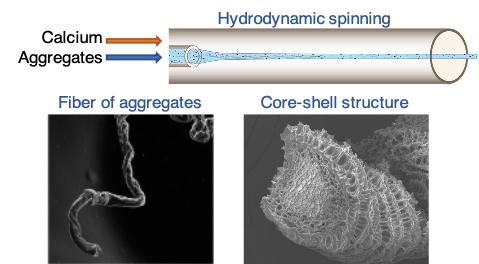
Abstract
Using fractal protein aggregates as building blocks, porous fibers were produced. The suspension of aggregates was coinjected with a solution of calcium chloride. Sol−gel transition of the suspension was induced by diffusion of calcium ions in the jet. The production of these fibers required a precise control of both hydrodynamic and physicochemical conditions as hydrodynamic instabilities competed with the gelation kinetics. By increasing the calcium concentration, several regimes were observed: swollen, dispersed, and shrunk fibers. In the first regime, homogeneous fibers were obtained. In the last one, osmotic phenomena led to a spontaneous core−shell structure with a dense shell.
Structural characterization of the interfacial self-assembly of chitosan with oppositely charged surfactant
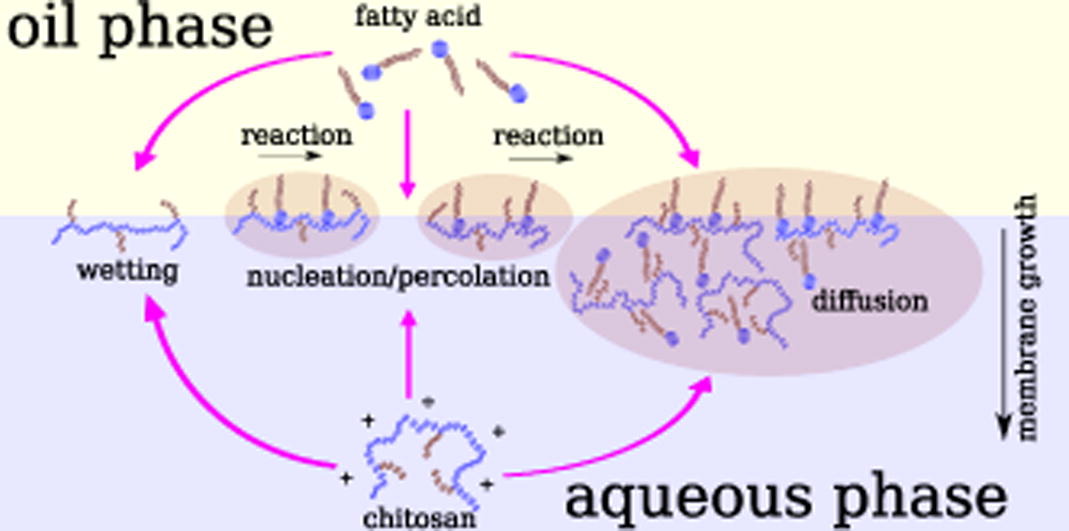
Abstract
Controlling the assembly of polyelectrolytes and surfactant at liquid–liquid interfaces offers new ways to fabricate soft materials with specific physical properties. However, little is known of the relationships between the kinetics of interfacial assembly, structural and rheological properties of such interfaces. We studied the kinetics at water–oil interface of the assembly of a positively charged biopolymer, chitosan, with an anionic fatty acid using a multi-scale approach. The growth kinetics of the membrane was followed by interfacial rheometry and space- and time- resolved dynamic light scattering. This set of techniques revealed that the interfacial complexation was a multi-step process. At short time-scale, the interface was fluid and made of heterogeneous patches. At a ‘gelation’ time, the surface elastic modulus and the correlation between speckles increased sharply meaning that the patches percolated. Confocal and electron microscopy confirmed this picture, and revealed that the basic brick of the membrane was sub-micrometric aggregates of chitosan/ fatty acid.
Membrane emulsification for the production of suspensions of uniform microcapsules with tunable mechanical properties

Abstract
A way forward for high throughput fabrication of microcapsules with uniform size and mechanical properties was reported irrespective of the kinetic process of shell assembly. Microcapsules were produced using lab-scale emulsification equipment with a micro-engineered membrane in the size range 10–100 µm. The shell of the microcapsules was assembled at the water-oil interface by complexation of polyelectrolytes or cross-linking of proteins providing two different kinetic processes. Elasticity of microcapsules was characterized with an automated extensional flow chamber.
Process parameters were optimized to obtain suspensions with size variations of 15%. Some strategies were developed to obtain uniform elastic properties according to the kinetics of shell assembly. If kinetics is limited by diffusion, membrane emulsification and shell assembly have to be split into two steps. If kinetics is limited by the quantity of reactants encapsulated in the droplet, variations of elastic properties result only from size variations.
Kinetic and structural characterization of whey protein aggregation in a millifluidic continuous process

Abstract
Whey protein isolates (WPI) can be aggregated upon heating to create new functional properties (e.g. texture), which depend on ag- gregate size and structural properties. In industrial conditions, aggregates are obtained in continuous processes at high temperature (≥ 75°C) in few minutes. When studying the kinetics of WPI aggregation at high temperature and under flow, one major issue is to develop a process in which heat transfer does not limit aggregation. To this end, we used a down-scaling approach in which a WPI solution flows in a heated capillary tube. We show that this process makes it possible to study both the kinetics of aggregation after few seconds and its dependence with the mean shear rate in isothermal conditions. The size and mass of aggregates and protein conformation were characterized by small-angle X-ray scattering and resonant mass measurement for a single physico-chemical condition (pH 7.0, 10 mM NaCl, 92°C, 4 % w/w WPI) which led to sub-micrometric aggregates. Firstly, we report that the size of aggregates were three times larger than when produced in a test tube. Secondly, the size and mass of aggregates reached a steady-state value in a few seconds, whereas the kinetics of aggregation and denaturation had a characteristic time of few minutes. Thirdly, the shear rate had no significant effect on the size of the aggregates, or on the aggregation kinetics. We concluded that WPI aggregation at 92°C is limited by a step of nucleation, and that the fact that aggregates produced in test tube were smaller is due to a slower thermalization.
Interfacial rheological properties of self-assembling biopolymer microcapsules
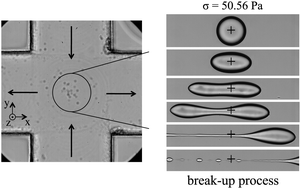
Abstract
Tuning the mechanical properties of microcapsules through a cost-efficient route of fabrication is still a challenge. The traditional method of layer-by-layer assembly of microcapsules allows building a tailored composite multi-layer membrane but is technically complex as it requires numerous steps. The objective of this article is to characterize the interfacial rheological properties of self-assembling biopolymer microcapsules that were obtained in one single facile step.
This thorough study provides new insights into the mechanics of these weakly cohesive membranes. Firstly, suspensions of water-in-oil microcapsules were formed in microfluidic junctions by self-assembly of two oppositely charged polyelectrolytes, namely chitosan (water soluble) and phosphatidic fatty acid (oil soluble). In this way, composite membranes of tunable thickness (between 40 and 900 nm measured by AFM) were formed at water/oil interfaces in a single step by changing the composition. Secondly, microcapsules were mechanically characterized by stretching them up to break-up in an extensional flow chamber which extends the relevance and convenience of the hydrodynamic method to weakly cohesive membranes. Finally, we show that the design of microcapsules can be ‘engineered’ in an extensive way since they present a wealth of interfacial rheological properties in terms of elasticity, plasticity and yield stress whose magnitudes can be controlled by the composition. These behaviors are explained by the variation of the membrane thickness with the physico-chemical parameters of the process.

Gastrointestinal fluid mechanics & motility
Hydrodynamics in a villi-patterned channel due to pendular-wave activity
Abstract
Inspired by the motility of small intestine, we investigate the flow generated by a propagating pendular-wave along the walls of a symmetric 2D channel lined with elongated villi-like microstructures. The rigid villi follow simple harmonic axial motion, but with a phase lag to their neighbours, resulting in travelling intervillous contractions. We use lattice Boltzmann simulations to resolve the flow around the villi and the luminal channel space, sampling small to moderate Womersley numbers. We analyse an emergent `mixing' boundary layer in the lumen, separating two distinct flow regions. A mixing region is formed above the villi, characterised by semi-vortical flow patterns, which travel along with the wave. In the channel centre, unidirectional axial flow emerges, flowing opposite to the imposed wave direction, even in the Stokes flow regime. This behaviour contrasts with canonical wave driven peristaltic flow (Jaffrin & Shapiro 1971). The fluid trapped in the intervillous gaps is forced to take a non-reciprocal path due to the travelling pendular-wave, which breaks time-symmetry in the Stokes regime. We propose an effective velocity boundary condition, incorporating perturbations due to the presence of the villi. In the inertial regime, the boundary layer shrinks due to dynamic flow confinement arising from increased oscillatory flow inertia. We identify the Stokes to inertial transition, and find phenomenological scaling laws for the boundary layer decay and axial and radial fluid fluxes. Our results not only advance the understanding of transport within the gut but also suggest a novel way for microfluidic flow control in confined channels.Flow simulations of rectal evacuation: towards a quantitative evaluation from video defaecography
Abstract
Mechanistic understanding of anorectal (patho)physiology is missing to improve the medical care of patients suffering from defaecation disorders. Our objective is to show that complex fluid dynamics modelling of video defaecography may open new perspectives in the diagnosis of defaecation disorders. Based on standard X-ray video defaecographies, we developed a bi-dimensional patient-specific simulation of the expulsion of soft materials, the faeces, by the rectum. The model quantified velocity, pressure and stress fields during the defaecation of a neostool with soft stool-like rheology for patients showing normal and pathological defaecatory function. In normal defaecation, the proximal–distal pressure gradient resulted from both the anorectal junction which formed a converging channel and the anal canal. The flow of the neostool through these anatomical parts was dominated by its shear-thinning viscous properties, rather than its yield stress. Consequently, the evacuation flow rate was significantly affected by variations in pressure applied by the rectum, and much less by the geometry of the anorectal junction. Lastly, we simulated impaired defaecations in the absence of obvious obstructive phenomena. Comparison with normal defaecation allowed us to discuss critical elements which should lead to effective medical management.Towards an assessment of rectal function by coupling X-ray defecography and fluid mechanical modelling
Abstract
Despite the numerous available clinical investi-gation tests, the associated alteration of quality of life and the socio-economic cost, it remains difficult for physicians to identify the pathophysiological origins of defecation disorders and therefore to provide the appropriate clinical care. Based on standardized dynamic X-ray defecography, we developed a 2D patient-specific computational fluid dynamic model of rectal evacuation. X-ray defecography was carried out in a sitting position with a standardized paste whose yield stress matched that of soft human feces. The flow was simulated with lattice-Boltzmann methods for yield stress fluids and moving boundary conditions. The model was applied for a patient with a normal recto-anal function. We deduced from the flow field that the main flow resistance during the defecation was due to the extrusion of the paste through the anal canal. We calculated also from pressure and stress fields the spatio-temporal evolution of the wall normal stress. This latter highlighted a gradient from the proximal to the distal part of the rectum. We discussed how this new set of hydrodynamical and biome-chanical parameters could be interpreted to gain new insights on the physiology of defecation and to diagnose underlying evacuation disorders. Clinical relevance - If confirmed, our approach should allow clinicians to obtain other parameters from a classic clinical examination and thus better adapt the response of clinicians to the defecation disorders observed in patients.Steady streaming flow induced by active biological microstructures; application to small intestine villi
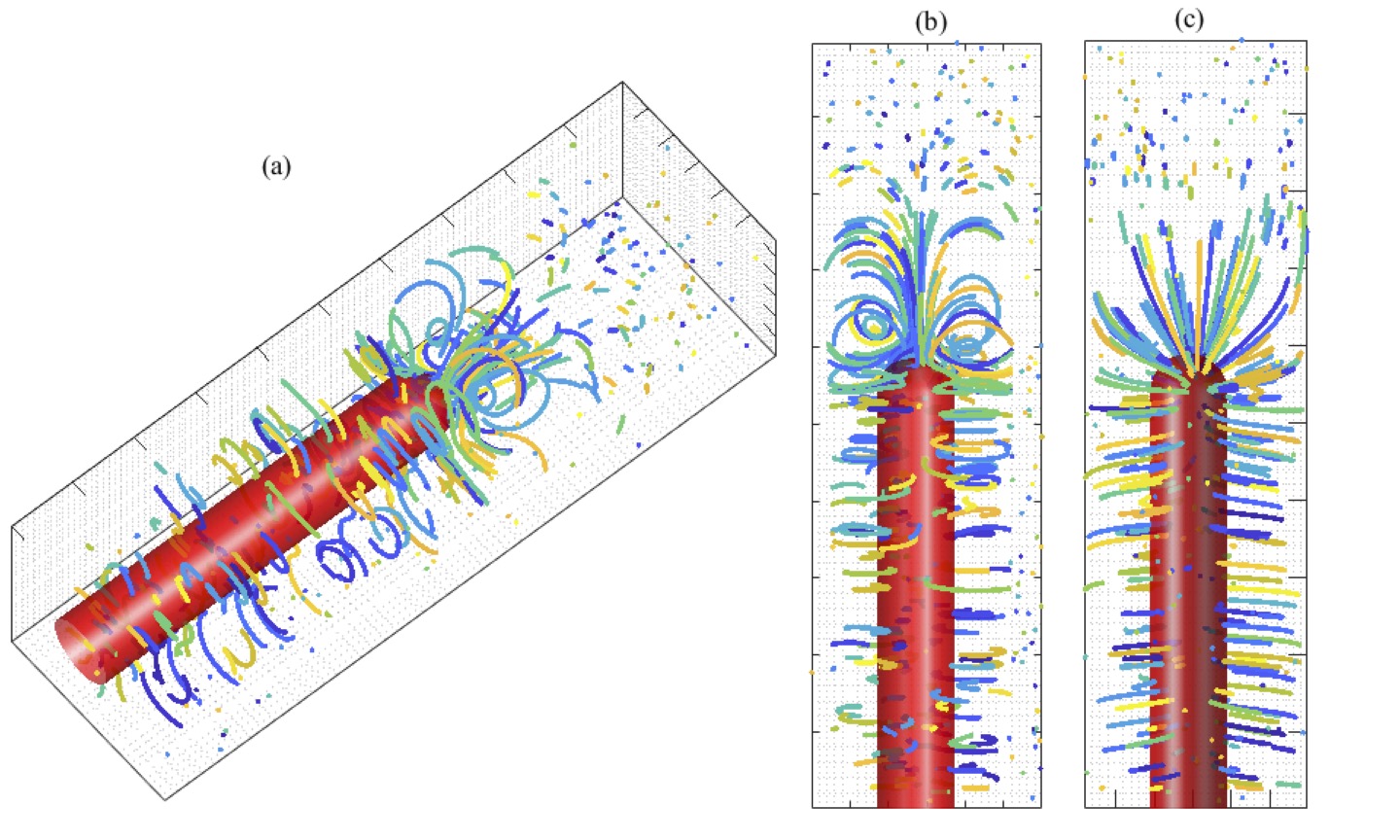
Abstract
Physiological transport of fluid at small scales is often achieved by microscopic active fingerlike structures. It is recognized that they have to move in a non-symmetric fashion in order to break the symmetry of creeping flow and to induce a net movement of the fluid. However, in the limit of low, but non-vanishing, Reynolds number, irreversible flow on long time scales could also be generated by symmetric oscillations of these microstructures. Inspired by small intestine villi, we reported three dimensional direct numerical simulations of the irreversible part of the flow, namely steady streaming flow (SSF), generated by an array of oscillating fingerlike structures. In order to capture these second order flow phenomena, the algorithm was based on a combination of lattice-Boltzmann methods with two relaxation times and the smoothed profile method. SSF was confined inside a steady viscous boundary above the villi. Two steady vortices at the tip of the villi characterized this flow which induced mass transfers between the bulk and the periphery. Strikingly, the spatial extension of these vortices was not solely governed by the Stokes boundary layer but also by the lateral confinement between the villi. Moreover, secondary vortices outside the steady boundary layer were also observed. These findings were rationalized in a state diagram showing three regimes of SSF. Finally, orders of magnitude showed that SSF should contribute to the transport of particles, such as bacteria or nano-particles, on a layer a few hundred micrometers above the villi and on a time scale of few minutes.Rheology of human faeces and pathophysiology of defaecation
Abstract
Background
Rectal evacuation involves multiple mechanisms that are not completely understood. The aim of this study was to quantify the rheologic property, i.e. yield stress, that governs the ease of deformation of a range of faeces of differing consistency and understand its influence on the pathophysiology of defaecation.Methods
Yield stresses of faeces of differing consistencies and Bristol scores were determined by the Vane test. We then explored the effects of this property on ease of defecation using a simple static model of the recto-anal junction based on the laws of flow for yield stress pastes and checked the conclusions by X-ray defaecography experience.Results
The yield stress of faeces increased exponentially with their solid content, from 20 to 8000 Pa. The static model of the recto-anal junction showed that evacuation of faeces of normal consistency and yield stress is possible with moderate dilatation of the anal canal, whilst the evacuation of faeces with higher yield stress requires greater dilatation of the anal canal. X-ray defaecography showed that such increases occurred in vivo.Conclusions
The diameter of the recto-anal junction is increased to enable the passage of feces with high yield stress. The finite limits to such dilation likely contribute to fecal impaction. Hence difficulties in defaecation may result either from unduly high yield stress or pathologies of reflex recto-anal dilatation or a combination of the two.Ex vivo motility in the base of the rabbit caecum and its associated structures: an electrophysiological and spatiotemporal analysis
Abstract
We examined the coordination between contractile events at different sites in the basal portion of the rabbit caecum and its associated structures that were identified by electrophysiological recordings with simultaneous one-dimensional, and a novel two-dimensional, spatiotemporal mapping technique. The findings of this work provide evidence that the caecum and proximal colon/ampulla coli act reflexly to augment colonic outflow when the caecum is distended and mass peristalsis instituted, the action of the latter overriding the inherent rhythm and direction of haustral propagation in the adjacent portion of the proximal colon but not in the terminal ileum. Further, the findings suggest that the action of the sacculus rotundus may result from its distension with chyme by ileal peristalsis and that the subsequent propagation of contraction along the basal wall of the caecum towards the colon may be augmented by this local distension.A review of mixing and propulsion of chyme in the small intestine: fresh insights from new methods
Abstract
The small intestine is a convoluted flexible tube of inconstant form and capacity through which chyme is propelled and mixed by varying patterns of contraction. These inconstancies have prevented quantitative comparisons of the manner in which contractile activity engenders mixing of contained chyme. Recent quantitative work based on spatiotemporal mapping of intestinal contractions, macro- and micro-rheology, particle image velocimetry and real-time modelling has provided new insights into this process. Evidence indicates that the speeds and patterns of the various types of small intestinal contraction are insufficient to secure optimal mixing and enzymatic digestion over a minimal length of intestine. Hence particulate substrates and soluble nutrients become dispersed along the length of the lumen. Mixing within the lumen is not turbulent but results from localised folding and kneading of the contents by contractions but is augmented by the inconstant spatial disposition of the contractions and their component contractile processes. The latter include inconstancies in the sites of commencement and the directions of propagation of contraction in component groups of smooth muscle cells and in the coordination of the radial and circular components of smooth muscle contraction. Evidence suggests there is ongoing augmentation of mixing at the periphery of the lumen, during both the post-prandial and inter-meal periods, to promote flow around and between adjacent villi. This results largely from folding of the relatively inelastic mucosa during repeated radial and longitudinal muscular contraction, causing chyme to be displaced by periodic crowding and separation of the tips of the relatively rigid villi. Further, micro-rheological studies indicate that such peripheral mixing may extend to the apices of enterocytes owing to discontinuities in the mobile mucus layer that covers the ileal mucosa.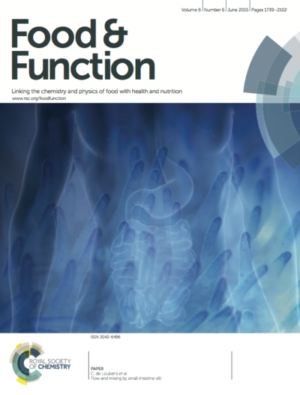
Abstract
Flow and mixing in the small intestine are multi-scale processes. Flows at the scale of the villi (finger-like structures of ≈500 μm length) are poorly understood. We developed a three-dimensional lattice-Boltzmann model to gain insight into the effects of villous movements and the rheology of digesta on flow, mixing and absorption of nutrients at the periphery of the intestinal lumen. Our model simulated the hydrodynamic consequences of villi movements that resulted from folding of the mucosa during longitudinal contractions. We found that cyclic approximation and separation of groups of villi generated laminar eddies at the edges of the group and augmented mass transfers in the radial direction between the inter-villous space and the intestinal lumen which improved the absorption of nutrients and mixing at the periphery of the lumen. This augmentation was greater with highly diffusible nutrients and with high levels of shear-thinning (pseudoplasticity) of the fluid. We compared our results with bulk flows simulations done by previous workers and concluded that villous movements during longitudinal contractions is a major radial mixing mechanism in the small intestine and increases mixing and absorption around the mucosa despite adverse rheology.
Spatiotemporal organization of standing postprandial contractions in the distal ileum of the anesthetized pig
Abstract
Background
Spatiotemporal (ST) mapping has mainly been applied to ex vivo preparations of the gut. We report the results of ST mapping of the spontaneous and remifentanil-induced motility of circular and longitudinal muscles of the distal ileum in the postprandial anaesthetized pig.
Methods
Spatiotemporal maps of strain rate were derived from image sequences of an exteriorized loop of ileum on a superfusion tray at laparotomy. Parameters were obtained by direct measurement from these maps, and by auto- and cross-correlation of map segments.
Key Results
Localized domains of standing longitudinal and circular activity that alternated between neighboring domains occurred spontaneously and both were promptly extinguished following intraluminal dosage with lidocaine. Longitudinal or circular contractions within a domain typically occurred at times that would coincide with every second or third cycle of the slow wave but propagated within the domain at a rate consistent with that reported within spike patches. Shortly after intravenous administration of remifentanil, longitudinal and circular contractions at the reported slow wave frequency propagated over longer distances at a high speed before slowing to a rate similar to that reported for slow waves.
Conclusions & Inferences
ST mapping based on cross-correlation is a robust tool for the analysis of intestinal movement and minimizing movement artefacts. We propose that the ST pattern of standing longitudinal and circular contractions arises from variation in the refractory period of smooth muscle, and hence, in its response to successive slow waves with neural stimuli influencing the former and having a mainly permissive role.
Determination of Villous Rigidity in the Distal Ileum of the Possum (Trichosurus vulpecula)
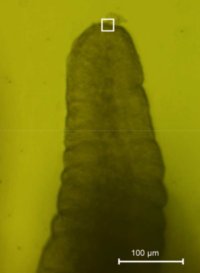
Abstract
We investigated the passive mechanical properties of villi in ex vivo preparations of sections of the wall of the distal ileum from the brushtail possum (Trichosurus vulpecula) by using a flow cell to impose physiological and supra-physiological levels of shear stress on the tips of villi. We directly determined the stress applied from the magnitude of the local velocities in the stress inducing flow and additionally mapped the patterns of flow around isolated villi by tracking the trajectories of introduced 3 µm microbeads with bright field micro particle image velocimetry (mPIV). Ileal villi were relatively rigid along their entire length (mean 550 µm), and exhibited no noticeable bending even at flow rates that exceeded calculated normal physiological shear stress (>0.5 mPa). However, movement of villus tips indicated that the whole rigid structure of a villus could pivot about the base, likely from laxity at the point of union of the villous shaft with the underlying mucosa. Flow moved upward toward the tip on the upper portions of isolated villi on the surface facing the flow and downward toward the base on the downstream surface. The fluid in sites at distances greater than 150 µm below the villous tips was virtually stagnant indicating that significant convective mixing in the lower intervillous spaces was unlikely. Together the findings indicate that mixing and absorption is likely to be confined to the tips of villi under conditions where the villi and intestinal wall are immobile and is unlikely to be greatly augmented by passive bending of the shafts of villi.
Characterisation of Mixing in the Proximal Duodenum of the Rat during Longitudinal Contractions and Comparison with a Fluid Mechanical Model Based on Spatiotemporal Motility Data
Abstract
The understanding of mixing and mass transfers of nutrients and drugs in the small intestine is of prime importance in creating formulations that manipulate absorption and digestibility. We characterised mixing using a dye tracer methodology during spontaneous longitudinal contractions, i.e. pendular activity, in 10 cm segments of living proximal duodenum of the rat maintained ex-vivo. The residence time distribution (RTD) of the tracer was equivalent to that generated by a small number (8) of continuous stirred tank reactors in series. Fluid mechanical modelling, that was based on real sequences of longitudinal contractions, predicted that dispersion should occur mainly in the periphery of the lumen. Comparison with the experimental RTD showed that centriluminal dispersion was accurately simulated whilst peripheral dispersion was underestimated. The results therefore highlighted the potential importance of micro-phenomena such as microfolding of the intestinal mucosa in peripheral mixing. We conclude that macro-scale modeling of intestinal flow is useful in simulating centriluminal mixing, whereas multi-scales strategies must be developed to accurately model mixing and mass transfers at the periphery of the lumen.
Mucosal microfolds augment mixing at the wall of the distal ileum of the brushtail possum
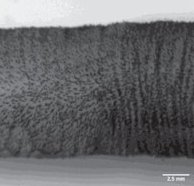
Abstract
Background
Recent work suggests that mixing in the small intestine takes place in central luminal and peripheral compartments. However, while movements of villi have been described, the mechanisms by which peripheral mixing are engendered remain unclear.
Methods
We examined the disposition and movement of mucosa and associated villi during contractions of the everted terminal ileum of the brushtail possum. We then simulated the effect of these movements on peripheral mixing.
Key Results
Compression of the intestinal mucosa by phasic longitudinal or radial contractions created short-lived microfolds, which were of similar scale to the attached villi. The packing density of the villous tips increased in the concavities and decreased on the crests of these microfolds. Simulations showed that these caused liquid digesta to be expelled from, or drawn into, intervillous spaces, significantly augmenting peripheral, but not bulk, luminal mixing.
Conclusions & Inferences
We describe a mechanism by which peripheral mixing may be engendered by mucosal microfolds without requiring the coordinated contraction of individual villi or groups of villi.
Fluid mechanical consequences of pendular activity, segmentation and pyloric outflow in the proximal duodenum of the rat and the guinea pig
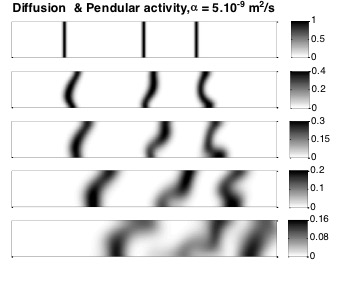
Abstract
We conducted numerical experiments to study the influence of non-propagating longitudinal and circular contractions, i.e. pendular activity and segmentation, respectively, on flow and mixing in the proximal duodenum. A lattice-Boltzmann numerical method was developed to simulate the fluid mechanical consequences for each of 22 randomly selected sequences of high-definition video of real longitudinal and radial contractile activity in the isolated proximal duodenum of the rat and guinea pig. During pendular activity in the rat duodenum, the flow was characterized by regions of high shear rate. Mixing was so governed by shearing deformation of the fluid that increased the interface between adjacent domains and accelerated their inter-diffusion (for diffusion coefficients approx. less than 10−8 m²s−1). When pendular activity was associated with a slow gastric outflow characteristic of post-prandial period, the dispersion was also improved, especially near the walls. Mixing was not promoted by isolated segmentative contractions in the guinea pig duodenum and not notably influenced by pylorus outflow. We concluded that pendular activity generates mixing of viscous fluids ‘in situ’ and accelerates the diffusive mass transfer, whereas segmentation may be more important in mixing particulate suspensions with high solid volume ratios.
Spatiotemporal mapping of the muscular activity of the gizzard of the chicken (Gallus domesticus)
Abstract
We report the results of spatiotemporal mapping of the spontaneous actions of component muscles of the gizzard and associated structures in ex vivo preparations with combined superfusion and vascular perfusion. Ongoing spontaneous contraction of cranial and caudal thin muscles occurred at a frequency of 2.2 ± 0.1 cycles per minute. Contractions of M. tenuis craniodorsalis with mean duration of 2.8 ± 0.2 s commenced ventrally adjacent to the distal limit of the proventriculus and progressed dorsally at 2.02 ± 0.03 mm∙s−1 in a concerted front. Near simultaneous contraction of M. tenuis caudoventralis of mean duration of contraction of 4.7 ± 0.7 s commenced dorsally and progressed ventrally at a similar rate (2.1 ± 0.1 mm∙s−1) and in a similar manner. Contraction of the caudoventralis preceded that of craniodorsalis (mean 1.1 ± 0.15 s). Contraction of the 2 tenuis muscles was synchronous with the first component peak of the cyclic increase in lumen pressure and with distension of the crassus musculature. Contraction of the M. crassus caudodorsalis muscle coincided with the second component peak and was followed by distension of the tenuis musculature. The latter commenced before the relaxation of the tenuis muscles. Contractions of the crassus muscle propagated rapidly at right angles to the orientation of the muscle fibers at a faster velocity than that of the tenuis musculature. The durations of the component peaks in lumen pressure indicated that the duration of crassus contraction was similar to that of the tenuis musculature.
Spatiotemporal mapping of ex vivo motility in the caecum of the rabbit
Abstract
We used high definition radial, strain rate and intensity spatiotemporal mapping to quantify contractile movements of the body and associated structures of the rabbit caecum when the terminal ileum was being perfused with saline at a constant rate. This perfusion caused gradual distension of the caecum as a result of relative restriction of outflow from the ampulla caecalis. The body of the caecum exhibited two patterns of motility that appeared autonomous, i.e. occurred independently of any contractile activity at the inlet or outlet. Firstly, the pattern that we termed ladder activity consisted of an orderly sequential contraction of bundles of axially oriented circular muscle between the spiral turns of longitudinal muscle and proceeded either from base to tip or from tip to base at a similar frequency and velocity. Secondly, less-localised, rapidly propagating synchronous contractions of both circular and longitudinal muscle, which were more common when the caecum was distended, that were termed mass peristalsis. Movements of the ileum and sacculus rotundus occurred at the same frequency and were broadly coordinated. Distension of the distal sacculus occurred synchronously with contraction of the ileum and did not propagate in an orderly manner across the structure, i.e. was instantaneous. This pattern was consistent with hydrostatic distension. Contractions propagated through the ampulla caecalis in either an orad or an aborad direction at a similar frequency to, and broadly correlated with, those in the ileum. The frequencies of distension of the sacculus and of contraction in the ileum and ampulla were momentarily augmented during mass peristalsis. The authors conclude that there was some coordination between the contractile activity of the terminal ileum and the caecal ampulla during periods of ongoing inflow from the ileum and between these structures and the caecum during mass peristalsis.
A comparison of the organization of longitudinal and circular contractions during pendular and segmental activity in the duodenum of the rat and guinea pig
Abstract
Background
Little is known of the spatiotemporal organization of pendular duodenal contractions.
Methods
We used longitudinal and radial spatiotemporal mapping to examine and compare pendular and segmental contractile activity in the proximal duodenum of the rat and guinea pig when the lumen was perfused with saline or micellar decanoic acid.
Key Results
Isolated phasic longitudinal contractions occurred along the rat duodenum with a frequency of 36 ± 2 cpm and strain rate amplitude of 26.8 ± 8.0% s−1. These contractions occurred at fixed locations along the duodenum forming columns on the longitudinal strain rate map. The strain rate activity had local maxima at 4–6 points spaced at 7.7 ± 4.0 mm intervals along the duodenum and were uncoordinated between neighboring domains. Similarly disposed, less distinct, longitudinal contractions occurred in the guinea pig duodenum at a frequency of 25.2 ± 6.6 cpm with amplitude 6.8 ± 3.6% s−1 but these were generally accompanied by numerous circular contractions that were distributed over 4–5 fixed locations and occurred with a frequency of 9 ± 3 cpm. Isolated static circular muscle contractions also occurred but at a lower rate in the rat than the guinea pig. Both types of contractions propagated after dosage with tetrodotoxin, lidocaine, atropine, or apamin.
Conclusions & Inferences
Localized contractions during segmental and pendular activity had some features of the spike patches that are normally associated with slow wave propagation. However, the commencement of propagation following administration of neural blocking agents and cholinergic inhibitors indicates their localization is maintained by inhibitory elements of the enteric nervous system.

Drops, capsules, particles in flow
Suspensions of attractive microcapsules: A noncolloidal fragile gel?
Abstract
We investigated the rheological properties of suspensions of attractive microcapsules, which formed a weak gel at volume fractions as low as 0.1. These microcapsules, measuring 100 m in diameter, were constructed with a droplet of positively charged chitosan solution protected by a membrane formed through the complexation of chitosan with a negatively charged surfactant. Iso-density matched suspensions were achieved by dispersing these microcapsules in silicone oils. Plate-plate rheometry revealed that these suspensions displayed a yield stress ranging from about 0.1 to 3 Pa for increasing from 0.1 to 0.5. At much higher stresses, the suspension viscosity was almost shear independent. Furthermore, these suspensions exhibited a frequency sweep signature akin to attractive colloidal suspensions, with a shear elastic modulus plateauing at low frequencies, indicative of an elastic microstructure within the suspensions. Remarkably, a degree of microstructural anisotropy, reminiscent of fragile matter, was evidenced by the transient fluidization of the suspension when the direction of applied stress, which remained below the yield stress, was reversed. Beyond the yield stress, both symmetric and asymmetric stress reversal experiments demonstrated that the suspension structure was influenced by the applied stress. It changed from an anisotropic and fragile network at low stress levels to a dispersion of isolated particles at high stress levels. We concluded that suspensions of attractive microcapsules could be classified as a fragile particulate gel, whose microstructure depends on the stress and its direction.
Reversal of particle migration for viscoelastic solution at high solvent viscosity
Abstract
The imbalance of normal stress around a particle induces its transverse migration in pressure-driven viscoelastic flow, offering possibilities for particle manipulation in microfluidic devices. Theoretical predictions align with experimental evidence of particles migrating towards the center-line of the flow. However, these arguments have been challenged by both experimental and numerical investigations, revealing the potential for a reversal in the direction of migration for viscoelastic shear-thinning fluids. Yet, a significant property of viscoelastic liquids that remains largely unexplored is the ratio of solvent viscosity to the sum of solvent and polymer viscosities, denoted as \beta. We computed the lift coefficients of a freely flowing cylinder in a bi-dimensional Poiseuille flow with Oldroyd-B constitutive equations. A transition from a negative (center-line migration) to a positive (wall migration) lift coefficient was demonstrated with increasing \beta values. Analogous to inertial lift, the changes in the sign of the lift coefficient were strongly correlated with abrupt (albeit small) variations in the rotation velocity of the particle. We established a scaling law for the lift coefficient that is proportional, as expected, to the Weissenberg number, but also to the difference in rotation velocity between the viscoelastic and Newtonian cases. If the particle rotates more rapidly than in the Newtonian case, it migrates towards the wall; conversely, if the particle rotates more slowly than in the Newtonian case, it migrates towards the center-line of the channel. Finally, experiments in microfluidic slits confirmed migration towards the wall for viscoelastic fluids with high viscosity ratio.
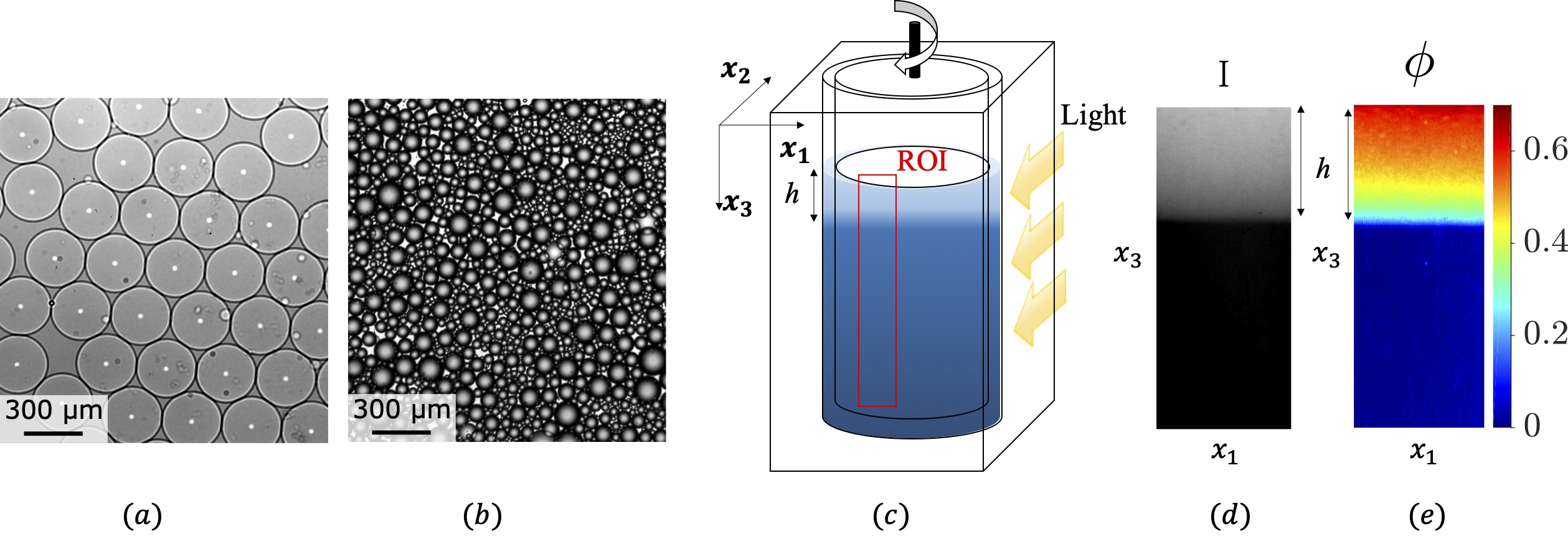
Abstract
Using absorbance measurements through a Couette cell containing an emulsion of buoyant droplets, volume fraction profiles are measured at various shear rates. These viscous resuspension experiments allow a direct determination of the normal stress in the vorticity direction in connection with the suspension balance model that has been developed for suspensions of solid particles. The results unambigously show that the normal viscosity responsible for the shear-induced migration of the droplets is independent on the capillary number, implying that particle deformation does not play a major role. It is similar to that of rigid particles at volume fractions below 40% but much smaller at higher ones.
Dynamics of particle migration in confined viscoelastic Poiseuille flows

Abstract
Particles migrate in the transverse direction of the flow due to the existence of normal stress anisotropy in weakly viscoelastic liquids. We test the ability of theoretical predictions to predict the transverse velocity migration of particles in a confined Poiseuille flow according to the viscoelastic constitutive parameters of dilute polymer solutions. First, we carefully characterize the viscoelastic properties of two families of dilute polymer solutions at various concentrations using shear rheometry and capillary breakup experiments. Second, we develop a specific three-dimensional particle tracking velocimetry method to measure with a high accuracy the dynamics of particles focusing in flow for Weissenberg numbers Wi ranging from 10-2 and 10-1, and particle confinement β of 0.1 and 0.2. The results show unambiguously that the migration velocity scales as Wiβ2, as expected theoretically for weakly elastic flows of an Oldroyd-B liquid. We conclude that classic constitutive viscoelastic laws are relevant to predict particle migration in dilute polymer solutions whereas detailed analysis of our results reveals that theoretical models overestimate by a few tenths the efficiency of particle focusing.
Perturbations of the flow induced by a microcapsule in a capillary tube
Abstract
Soft microcapsules moving in a cylindrical capillary deform from quasi-spherical shapes to elongated shapes with an inversion of curvature at the rear. We investigated the perturbation of the flow by particle tracking velocimetry around deformed microcapsules in confined flow. These experiments are completed by numerical simulations. Microcapsules are made of a thin membrane of polymerized human albumin and their shear elastic moduli are previously characterized in a cross flow chamber.
Firstly, the velocity of the microcapsule can be calculated by theoretical predictions for rigid spheres, even for large deformations as ’parachute-like’ shapes, if a relevant definition of the ratio of confinement is chosen. Secondly, at the rear and the front of the microcapsule, the existence of multiple recirculation regions is governed by the local curvature of the membrane. The amplitudes of these perturbations increase with the microcapsule deformation, whereas their axial extents are comparable to the radius of the capillary whatever the confinement and the capillary number. We conclude that whereas the motion of microcapsules in confined flow has quantitative similitudes with rigid spheres in term of velocity and axial extent of the perturbation, their presence induces variations in the flow field that are related to the local deformation of the membrane as in droplets.
Tank-treading of microcapsules in shear flow
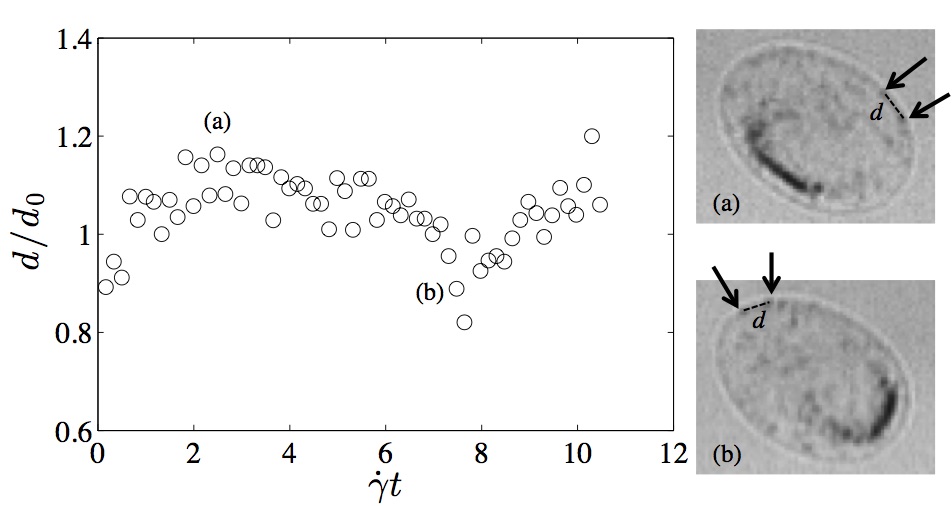
Abstract
We investigated experimentally the deformation of soft microcapsules and the dynamics of their membrane in simple shear flows. Firstly, the tank-treading motion, i.e. the rotation of the membrane, was visualized and quantified by tracking particles included in the membrane by a new protocol. The period of membrane rotation increased quadratically with the extension of the long axis. The tracking of the distance between two close microparticles showed membrane contraction at the tips and stretching on the sides, a specific property of soft particles such as capsules. The present experimental results are discussed in regard to previous numerical simulations.
This analysis showed that the variation of the tank-treading period with the Taylor parameter (deformation) cannot be explained by purely elastic membrane models. It suggests a strong effect of membrane viscosity whose order of magnitude is determined. Secondly, two distinct shapes of sheared microcapsules were observed. For moderate deformations, the shape was a steady ellipsoid in the shear plane. For larger deformations, the capsule became asymmetric and presented an S-like shape. When the viscous shear stress increased by three orders of magnitude, the short axis decreased by 70 % whereas the long axis increased by 100 % before any break-up. The inclination angle decreased from 40° to 8°, almost aligned with the flow direction as expected by theory and numerics on capsules and from experiments, theory and numerics on drops and vesicles. Whatever the microcapsule size and the concentration of proteins, the characteristic lengths of the shape, the Taylor parameter and the inclination angle satisfy master curves versus the long axis or the normalized shear stress or the capillary number in agreement with theory for non-negligible membrane viscosity in the regime of moderate deformations. Finally, we observed that very small deviation from sphericity gave rise to swinging motion, i.e. shape oscillations, in the small-deformation regime.
In conclusion, this study of tank-treading motion supports the role of membrane viscosity on the dynamics of microcapsules in shear flow by independent methods that compare experimental data both with numerical results in the regime of large deformations and with theory in the regime of moderate deformations.
Characterization of the mechanical properties of cross-linked serum albumin microcapsules: effect of size and protein concentration
Abstract
A microfluidic technique is used to characterize the mechanical behavior of capsules that are produced in a two-step process: first, an emulsification step to form droplets, followed by a cross-linking step to encapsulate the droplets within a thin membrane composed of cross-linked proteins. The objective is to study the influence of the capsule size and protein concentration on the membrane mechanical properties. The microcapsules are fabricated by cross-linking of human serum albumin (HSA) with concentrations from 15 to 35 % (w/v). A wide range of capsule radii (∼40–450 μm) is obtained by varying the stirring speed in the emulsification step. For each stirring speed, a low threshold value in protein concentration is found, below which no coherent capsules could be produced. The smaller the stirring speed, the lower the concentration can be. Increasing the concentration from the threshold value and considering capsules of a given size, we show that the surface shear modulus of the membrane increases with the concentration following a sigmoidal curve. The increase in mechanical resistance reveals a higher degree of cross-linking in the membrane. Varying the stirring speed, we find that the surface shear modulus strongly increases with the capsule radius: its increase is two orders of magnitude larger than the increase in size for the capsules under consideration. It demonstrates that the cross-linking reaction is a function of the emulsion size distribution and that capsules produced in batch through emulsification processes inherently have a distribution in mechanical resistance.Stretching of capsules in an elongation flow, a route to constitutive law

Abstract
Soft bio-microcapsules are drops bounded by a thin elastic shell made of cross-linked proteins. Their shapes and their dynamics in flow depend on their membrane constitutive law characterized by shearing and area-dilatation resistance. The deformations of such capsules are investigated experimentally in planar elongation flows and compared with numerical simulations for three bidimensional models: Skalak, neo-Hookean and generalized Hooke. An original cross-flow microfluidic set-up allows the visualization of the deformed shape in the two perpendicular main fields of view. Whatever the elongation rate, the three semi-axis lengths of the ellipsoid fitting the experimental shape are measured up to 180 % of stretching of the largest axis. The geometrical analysis in the two views is sufficient to determine the constitutive law and the Poisson ratio of the membrane without a preliminary knowledge of the shear elastic modulus . We conclude that the membrane of human serum albumin capsules obeys the generalized Hooke law with a Poisson ratio of 0.4. The shear elastic modulus is then determined by the combination of numerical and experimental variations of the Taylor parameter with the capillary number.
Mechanical characterization of cross-linked serum albumin microcapsules
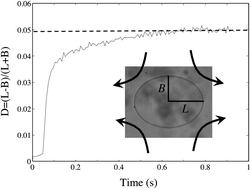
Abstract
Controlling the deformation of microcapsules and capsules is essential in numerous biomedical applications. The mechanical properties of the membrane of microcapsules made of cross-linked human serum albumin (HSA) are revealed by two complementary experiments in the linear elastic regime. The first provides the surfacic shear elastic modulus Gs by the study of small deformations of a single capsule trapped in an elongational flow: Gs varies from 0.002 to 5 N/m. The second gives the volumic Young's modulus E of the membrane by shallow and local indentations of the membrane with an AFM probe: E varies from 20 kPa to 1 MPa. The surfacic and volumic elastic moduli increase with the size of the capsule up to three orders of magnitude and with the protein concentration of the membrane. The membrane thickness is evaluated from these two membrane mechanical characteristics and increases with the size and the initial HSA concentration from 2 to 20 μm.

Food oral processing
An experimental model to investigate the biomechanical determinants of pharyngeal mucosa coating during swallowing

Abstract
The development of innovative experimental approaches is necessary to gain insights in the complex biomechanics of swallowing. In particular, unraveling the mechanisms of formation of the thin film of bolus coating the pharyngeal mucosa after the ingestion of liquid or semi-liquid food products is an important challenge, with implication in dysphagia treatment and sensory perceptions.The aim here is to propose an original experimental model of swallowing (i) to simulate the peristaltic motions driving the bolus from the oral cavity to the esophagus, (ii) to mimic and vary complex physiological variables of the pharyngeal mucosa (lubrication, deformability and velocity) and (iii) to measure the thickness and the composition of the coatings resulting from bolus flow. Three Newtonian glucose solutions were considered as model food boli, through sets of experiments covering different ranges of each physiological parameter mimicked. The properties of the coatings (thickness and dilution in saliva film) were shown to depend significantly on the physical properties of food products considered (viscosity and density), but also on physiological variables such as lubrication by saliva, velocity of the peristaltic wave, and to a lesser extent, the deformability of the pharyngeal mucosa. The biomechanical peristalsis simulator developed here can contribute to unravel the determinants of bolus adhesion on pharyngeal mucosa, necessary both for the design of alternative food products for people affected by swallowing disorders, and for a better understanding of the dynamic mechanisms of aroma perception.
Mechanistic Model To Understand in Vivo Salt Release and Perception during the Consumption of Dairy Gels
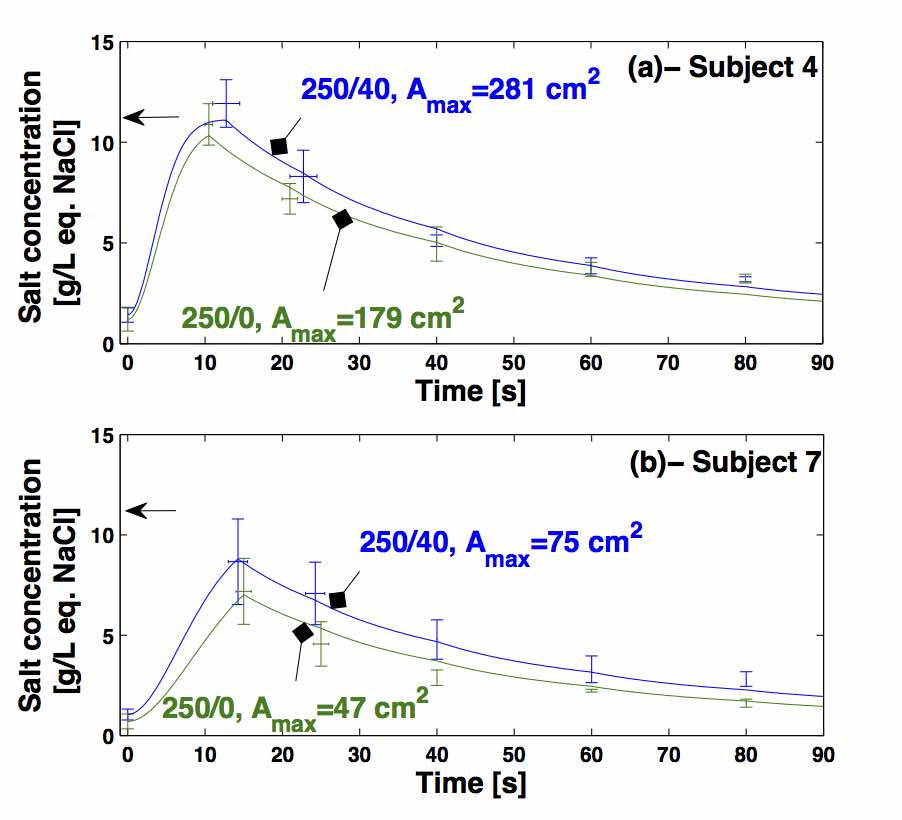
Abstract
The objective of this study was to develop a model to simulate salt release during eating. Salt release kinetics during eating was measured for four model dairy products with different dynamic salty perceptions. A simple in vivo model of salt release was developed to differentiate between the contribution of the individual and of the product to salt release. The most difficult model parameter to determine or predict is the evolution of the contact area between the product and the saliva. Fitting the model to the experimental data showed that the subject’s masticatory performance and fracture initiation energy of the product determined the contact area between the product and the saliva generated by mastication. Finally, the role of release dynamics on sensory time-intensity profiles is discussed.
Mechanisms explaining the role of viscosity and post-deglutitive pharyngeal residue on in vivo aroma release: A combined experimental and modeling study
Abstract
The objective of this study was to analyse the viscosity effect of liquid Newtonian products on aroma release, taking human physiological characteristics into account. In vivo release of diacetyl from glucose syrup solutions varying widely in viscosity (from 0.7 to 405 mPa s) was assessed by five panelists using Proton Transfer Reaction Mass Spectrometry (PTR-MS). The physicochemical properties of the solutions and the physiological parameters of subjects were experimentally measured. In parallel, a mechanistic model describing aroma release while eating a liquid food was developed. Model predictions based on the characteristics of the glucose syrup solution were invalidated when compared to in vivo measurements. Therefore, the assumption that the post-deglutitive pharyngeal residue was considerably diluted with saliva was introduced into the model. Under this hypothesis, the model gives a satisfactory prediction of the in vivo data. Thus, relevant properties to be considered for in vivo release were those of product-saliva mixes.
Mechanistic model of in vitro salt release from model dairy gels based on standardized breakdown test simulating mastication
Abstract
The temporal dominance of sensations method showed that four model dairy products had different dynamic profiles in terms of salt and texture perception. We investigated the physical origins of these differences, by studying the breakdown of these products and its impact on salt release. An experimental device was used for monitoring the kinetics of salt release from the food products into water – simulating saliva – after a standardized compression – simulating mastication – independently of the inter and intra individual variability. A mechanistic model was developed to quantify product breakdown in terms of the area of contact between the product and the aqueous phase. Fat had a major influence on breakdown behaviour and the calculated contact area that could be accounted for by the microstructure of the product. These results provide insight into the possible origins of differences in sensory perceptions of foods. We also discussed the use of this mechanistic model for modelling salt release in the conditions of food consumption.
A biomechanical model of swallowing for understanding the influence of saliva and food bolus viscosity on flavor release
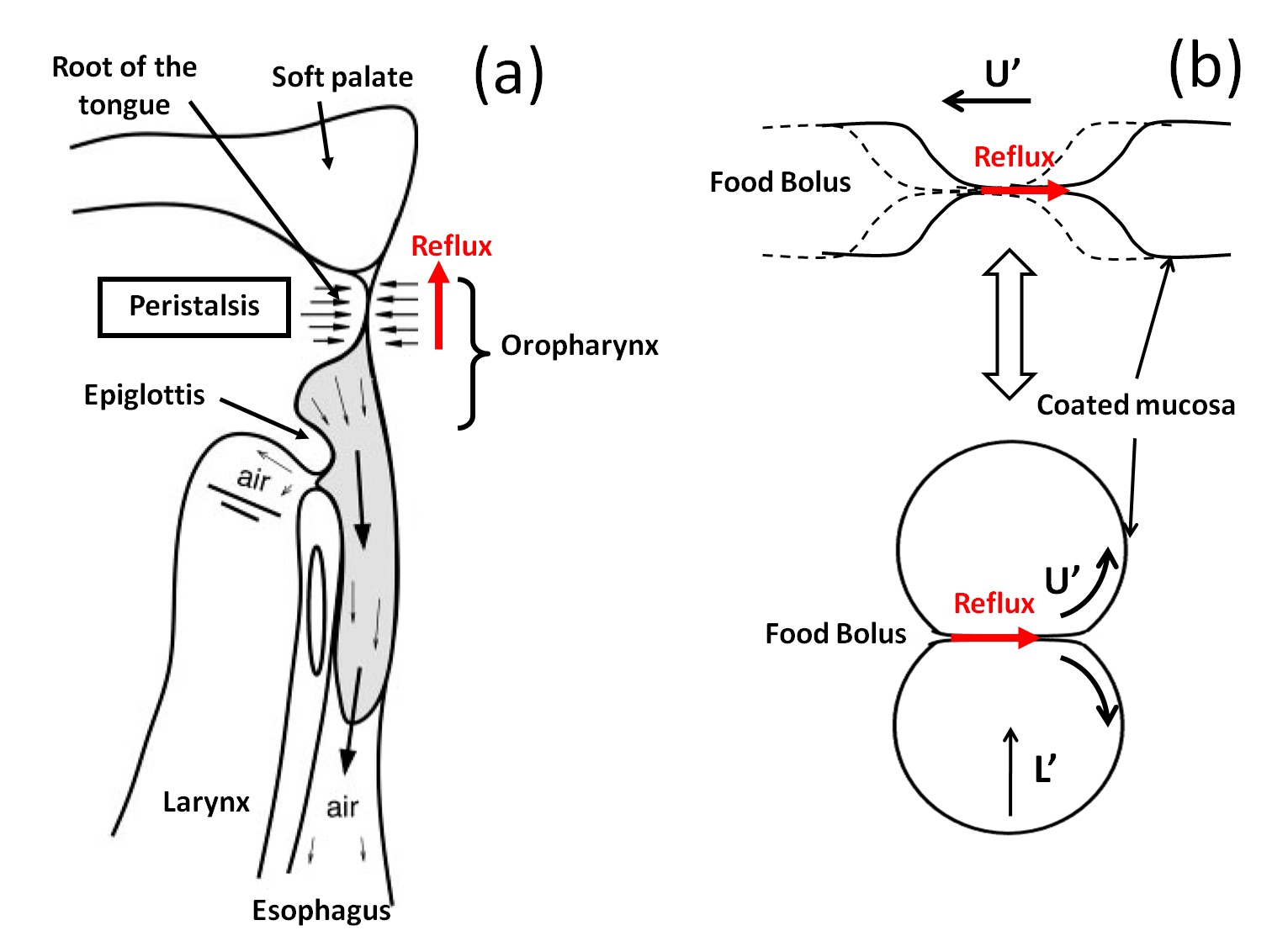
Abstract
After swallowing a liquid or a semi-liquid food product, a thin film responsible for the dynamic profile of aroma release coats the pharyngeal mucosa. The objective of the present article was to understand and quantify physical mechanisms explaining pharyngeal mucosa coating. An elastohydrodynamic model of swallowing was developed for Newtonian liquids that focused on the most occluded region of the pharyngeal peristaltic wave. The model took lubrication by saliva film and mucosa deformability into account. Food bolus flow rate and generated load were predicted as functions of three dimensionless variables: the dimensionless saliva flow rate, the viscosity ratio between saliva and the food bolus, and the elasticity number. Considering physiological conditions, the results were applied to predict aroma release kinetics.
Two sets of conditions were distinguished. The first one was obtained when the saliva film is thin, in which case food bolus viscosity has a strong impact on mucosa coating and on flavor release. More importantly, we demonstrated the existence of a second set of conditions. It was obtained when the saliva film is thick and the food bolus coating the mucosa is very diluted by saliva during the swallowing process and the impact of its viscosity on flavor release is weak. This last phenomenon explains physically in vivo observations for Newtonian food products found in the literature. Moreover, in this case, the predicted thickness of the mix of food bolus with saliva coating the mucosa is approximately of 20 μm; value in agreement with orders of magnitude found in the literature.
Understanding of the influence of composition, structure and texture on salty perception in model dairy products
Abstract
The aim of this study was to better understand salt release and perception in model dairy products, having different composition, structure and/or texture. Sensory and instrumental methods were used to quantify and relate texture to salt mobility and perception. A high dry matter content (protein and fat jamming) and a gel structure with a protein network formation induced a decrease of diffusion coefficient of salt in matrices. Moreover, salty perception was higher for non-renneted products than for gelled ones. For gels, saltiness was enhanced in fat products. These results were discussed in regards with textural and physico-chemical food properties: the structural parameter tan δ was the most correlated with salty perception highlighting the impact of product structure on saltiness. Results also demonstrated that physiology and complex events (mastication, dilution and mixing with saliva, dynamic of bolus formation) occurring during food consumption must be considered to go further in understanding.
A lubrication analysis of pharyngeal peristalsis: Application to flavour release
Abstract
After eating a liquid or a semi-liquid food product, a thin film responsible for the dynamic profile of aroma release coats the pharyngeal mucosa. The aim of this article was to analyse the fluid mechanics of pharyngeal peristalsis and to develop a simple biomechanical model in order to understand the role of saliva and food bolus viscosity on the coating of pharyngeal mucosa. We began by analysing the physiology and the biomechanics of swallowing in order to determine relevant model assumptions. This analysis of the literature clarified the types of mechanical solicitations applied on the food bolus. Moreover, we showed that the pharyngeal peristalsis in the most occluded region is equivalent to a forward roll coating process, the originality of which is lubrication by a film of saliva. A model based on the lubrication theory for Newtonian liquids was developed in dimensionless form. The parametric study showed the strong influence of relative saliva thickness on the food bolus coating. A specific experimental device was designed that confirms the model predictions. Two sets of conditions that depend on the relative thickness of saliva were distinguished. The first is characterised by a relatively thin film of saliva: food bolus viscosity has a strong impact on mucosa coating. These phenomena are well represented by the model developed here. The second is obtained when the saliva film is relatively thick: hydrodynamic mixing with saliva, interdiffusion or instabilities may govern mucosa coating. Finally, these results were extrapolated to determine the influence of food bolus viscosity on the dynamic profile of flavour release according to physiological parameters.
Compréhension et modélisation des phénomènes physiques régissant la libération des stimuli orosensoriels
Abstract
La compréhension et la modélisation des phénomènes régissant la libération des stimuli orosensoriels durant la consommation d’un aliment doit permettre de respecter des critères de conception à la fois nutritionnels et organoleptiques. Un modèle de libération du sel au cours de la mastication a été développé pour des produits « solides ». La déstructuration du produit a été appréhendée en terme de génération de surface de contact entre le produit et la salive qui gouverne les transferts de sel. La surface de contact a été considérée comme étant le produit de deux fonctions. La première est reliée au sujet et est fonction de son efficacité masticatoire. La seconde est reliée au produit et dépend de ses propriétés de déstructuration qui peuvent être déterminées par des tests in vitro. Durant la phase pharyngée, la biomécanique de la déglutition gouverne l’enduction des muqueuses par le bol alimentaire et ainsi la libération des composés d’arôme présents dans cette couche. Ces phénomènes sont régis par un écoulement en film mince, stationnaire, dans un contact élastohydrodynamique mou dont la cinématique équivaut à un processus d’enduction par des cylindres contrarotatifs lubrifiés par de la salive. Deux régimes ont été distingués. Lorsque le film de salive est fin, la viscosité du bol alimentaire a un grand rôle sur l’enduction et la libération des composés d’arôme. Lorsque le film de salive est épais, le bol est dilué par la salive durant le processus de déglutition et sa viscosité a un faible effet sur l’enduction et la libération des composés d’arôme. Ce second régime permet d’expliquer l’origine physique d’observations in vivo concernant la libération des composés d’arôme.
Rapid determination of partition and diffusion properties for salt and aroma compounds in complex food matrices
Abstract
The measurement of physicochemical properties, such as partition or diffusion coefficients of small molecules like salt and aroma compounds, represents an important challenge to better understanding stimuli release and perception. Owing to the lack of simple and fast methods, we developed three methods for practical and rapid determination of partition and diffusion coefficients respectively of salt and aroma compounds. Our approach is based on the combination of on-line measurements with mechanistic modelling leading to accurate determination of these two parameters. Validation was performed by comparing the values obtained with agar gel and model cheeses to those available in the literature.

Miscellaneous
Dynamics of a gel-based artificial tear film with an emphasis on dry disease treatment applications
Abstract
This paper discusses the spreading of gel-based ophthalmic formulation on the cornea surface assumed to be flat. We show that gel-based formulations exhibit rheological behaviors that the Herschel–Bulkley model can describe. The continuity and momentum equations are solved numerically using the monofluid formulation and the volume-of-fluid (VOF) method. We investigated the influence of the rheological properties, namely the consistency, the yield stress, and the flow behavior index, on the spreading of a gel-based artificial tear over the cornea surface. We propose optimal values of these properties for efficient gel-based artificial tears.
Cellulose nanofibrils prepared by twin-screw extrusion: Effect of the fiber pretreatment on the fibrillation efficiency
Abstract
Twin-screw extrusion (TSE) is a rather recent method to produce cellulose nanofibrils (CNFs) at a high solid content under continuous feeding. Here, never-dried commercial eucalyptus pulp was used as starting material to produce CNFs by TSE after a chemical pretreatment to introduce carboxylic groups via TEMPO-mediated oxidation and carboxymethylation. Five samples with a carboxyl content ranging from 800 to 1300 μmol.g−1 were produced to explore how the carboxyl content affects the aptitude of cellulose fibers to be broken down to nanoscale. The properties of the resulting CNFs in terms of nanosized fraction, morphology and rheological properties were investigated. A critical carboxyl content of 700 μmol.g−1was a prerequisite for the successful conversion of cellulose fibers into a CNF gel by TSE, regardless the pretreatment method. The degree of swelling of the fibers was put forward to account for this critical parameter.
The fluid mechanics of shear-thinning tear substitutes
Abstract
Tear substitutes are used to treat dry eye syndrome. Shear-thinning should help to delay the appearance of dry spots and improve comfort. This article discusses a numerical model study of the spreading of shear-thinning tear substitutes during blinking. The Ellis model, which takes account of the Newtonian plateau at low shear rate, was chosen. Flow is governed by the capillary number Ca, the shear-thinning index of the fluid α, and a third dimensionless number L2, representing surface tension effects in relation to shear-thinning effects. The numerical solution was validated by scaling laws and by results found in the literature for the Newtonian case. An optimisation process was applied to determine the ranges of Ca, α, and L2, that would ensure greater stability of the tear film than with Newtonian substitutes. The results obtained are illustrated with the cases of two substitutes